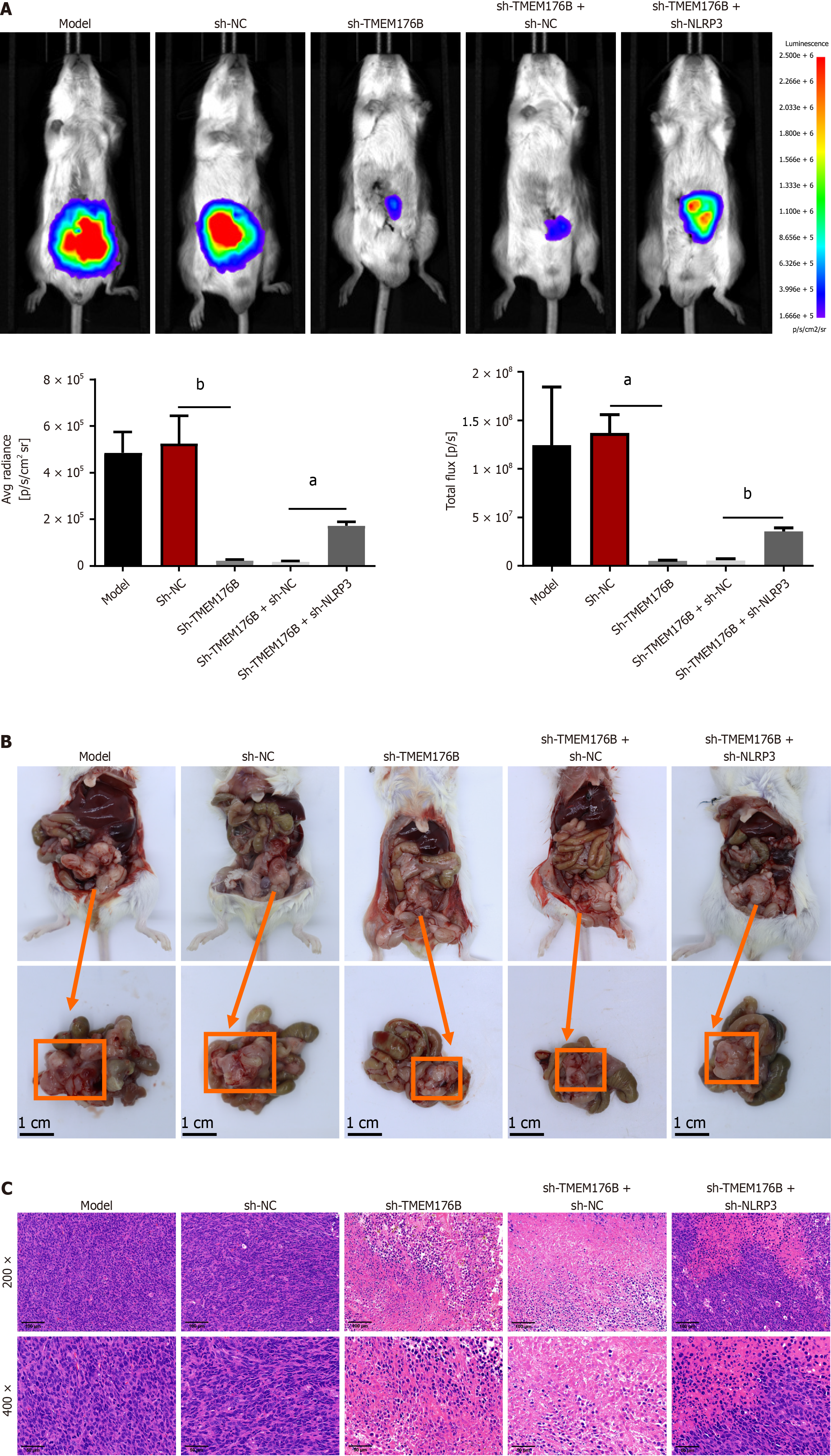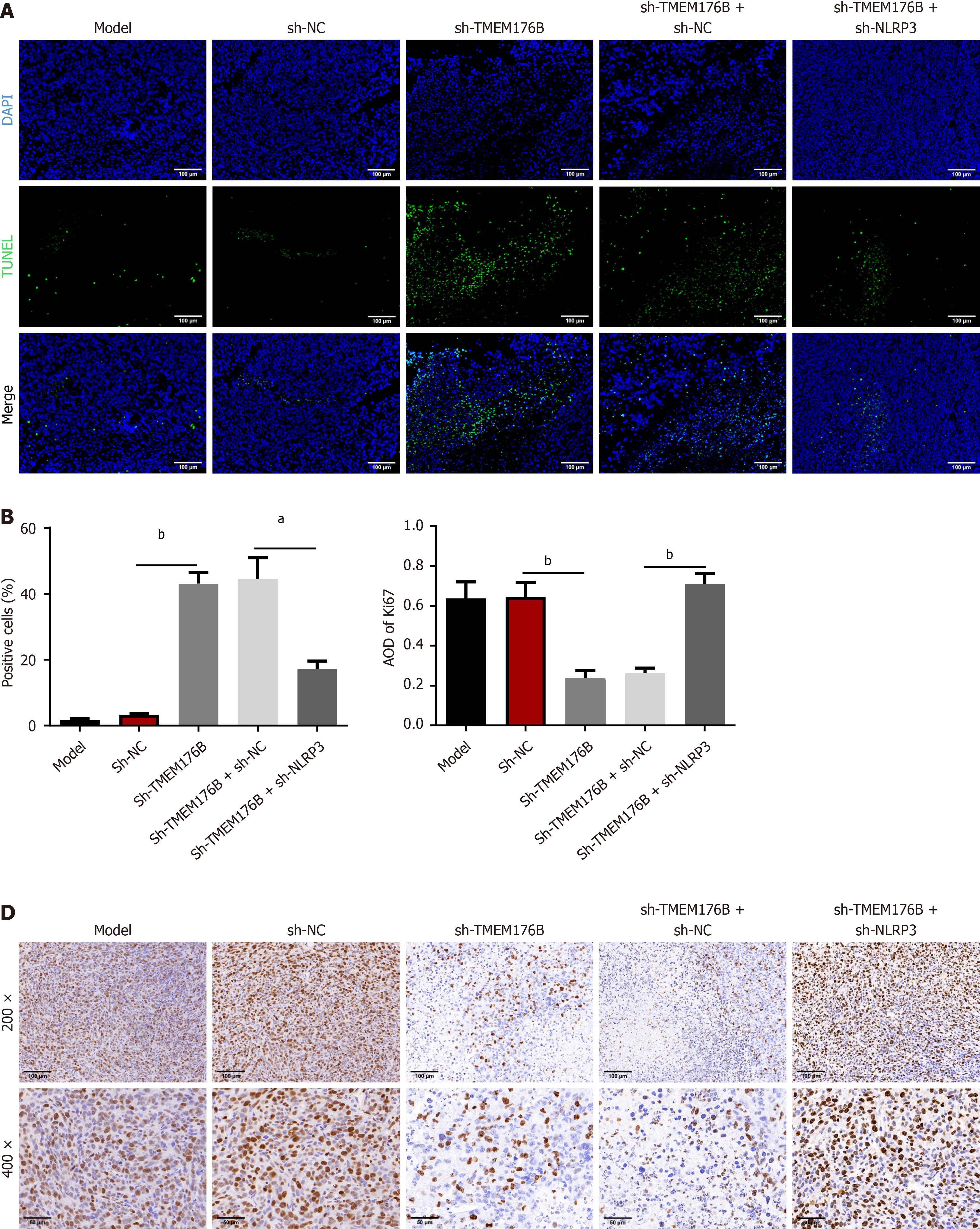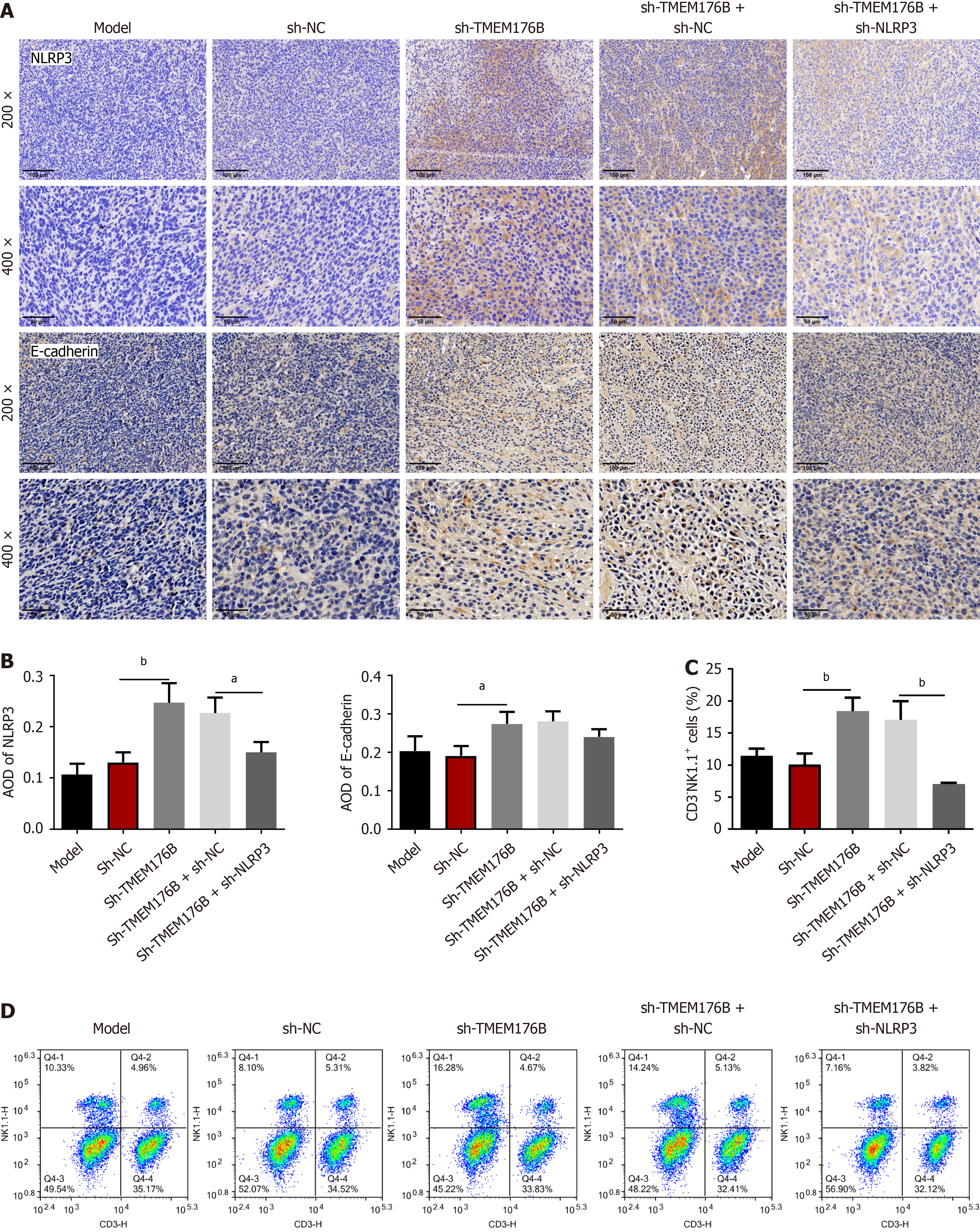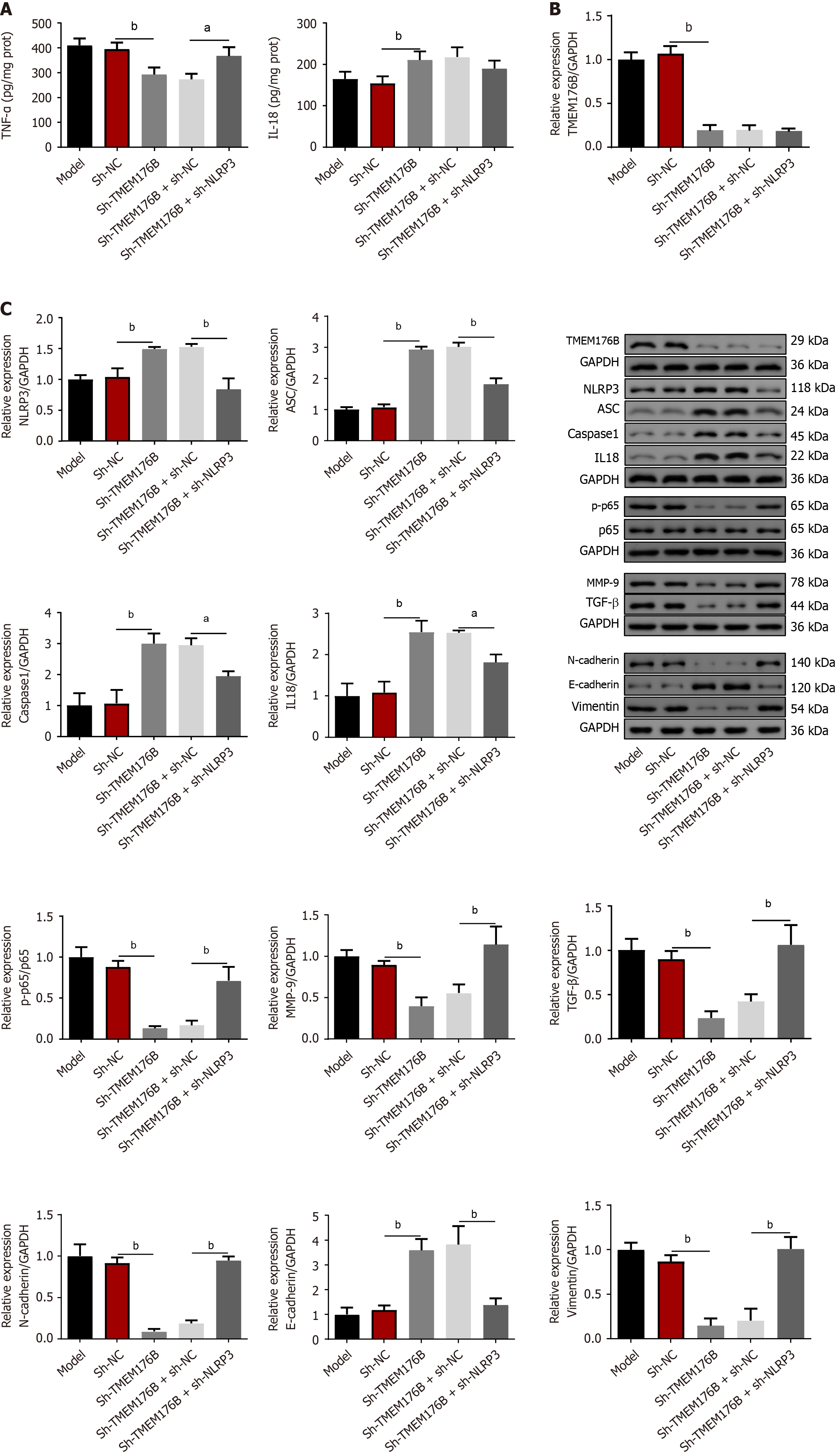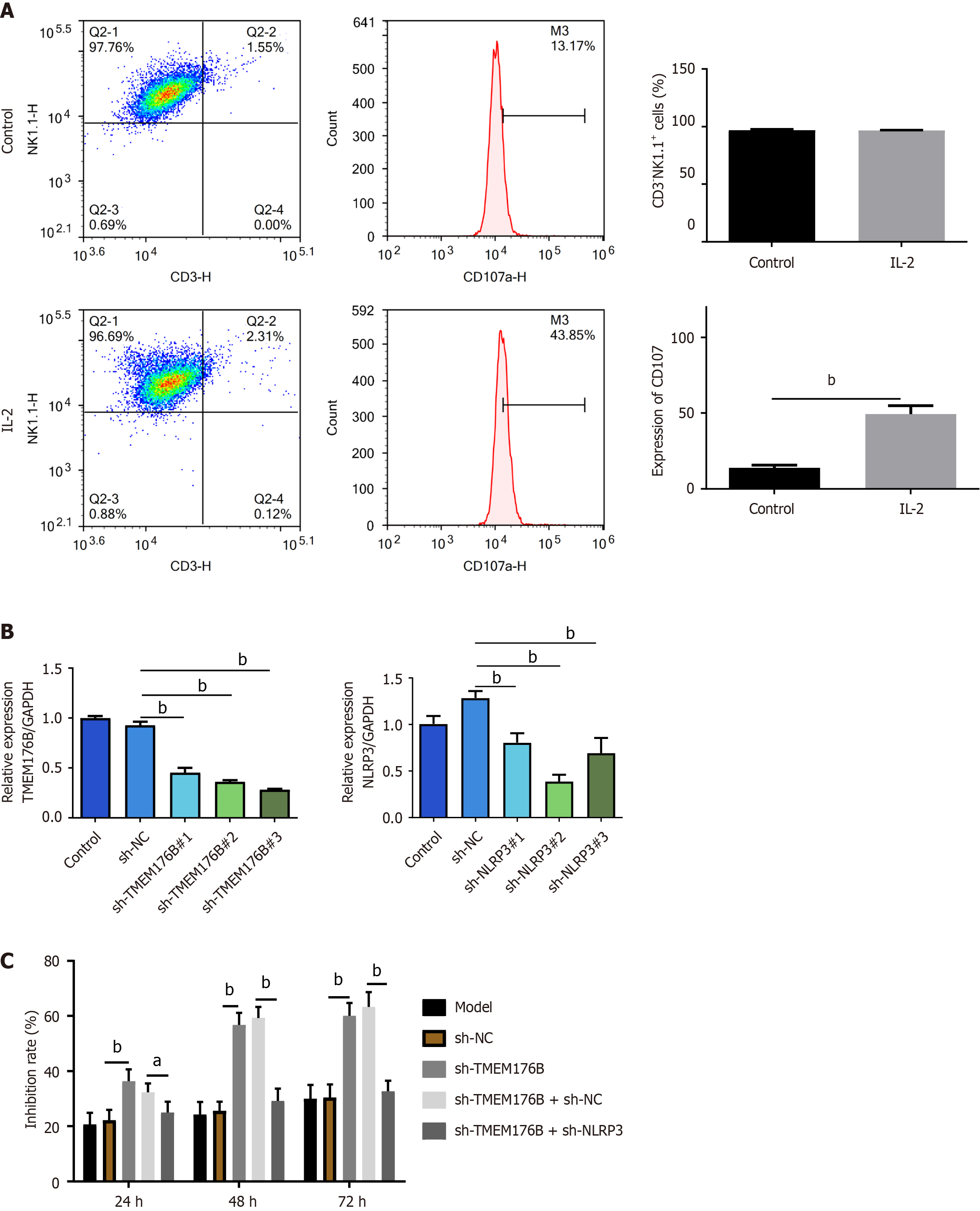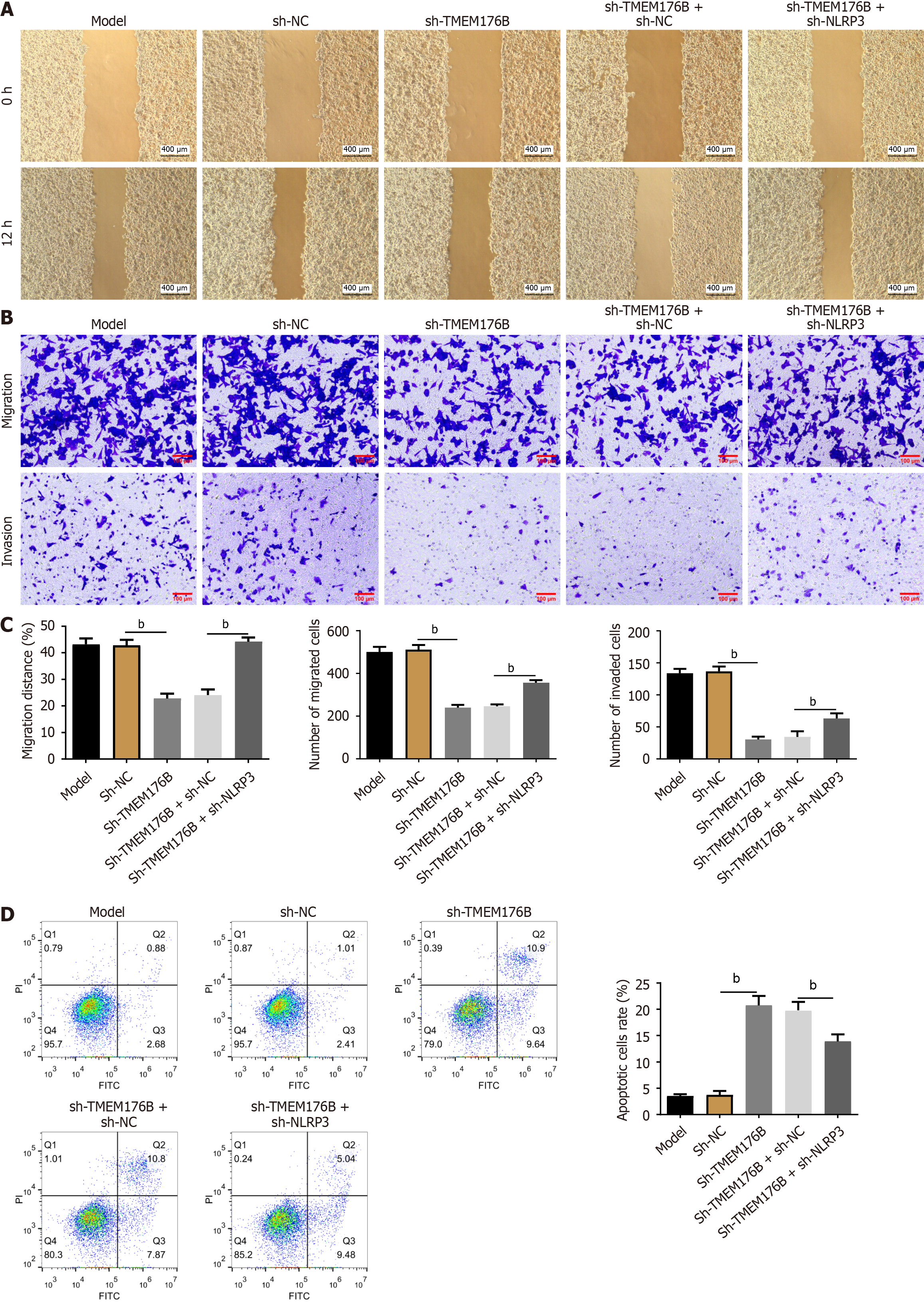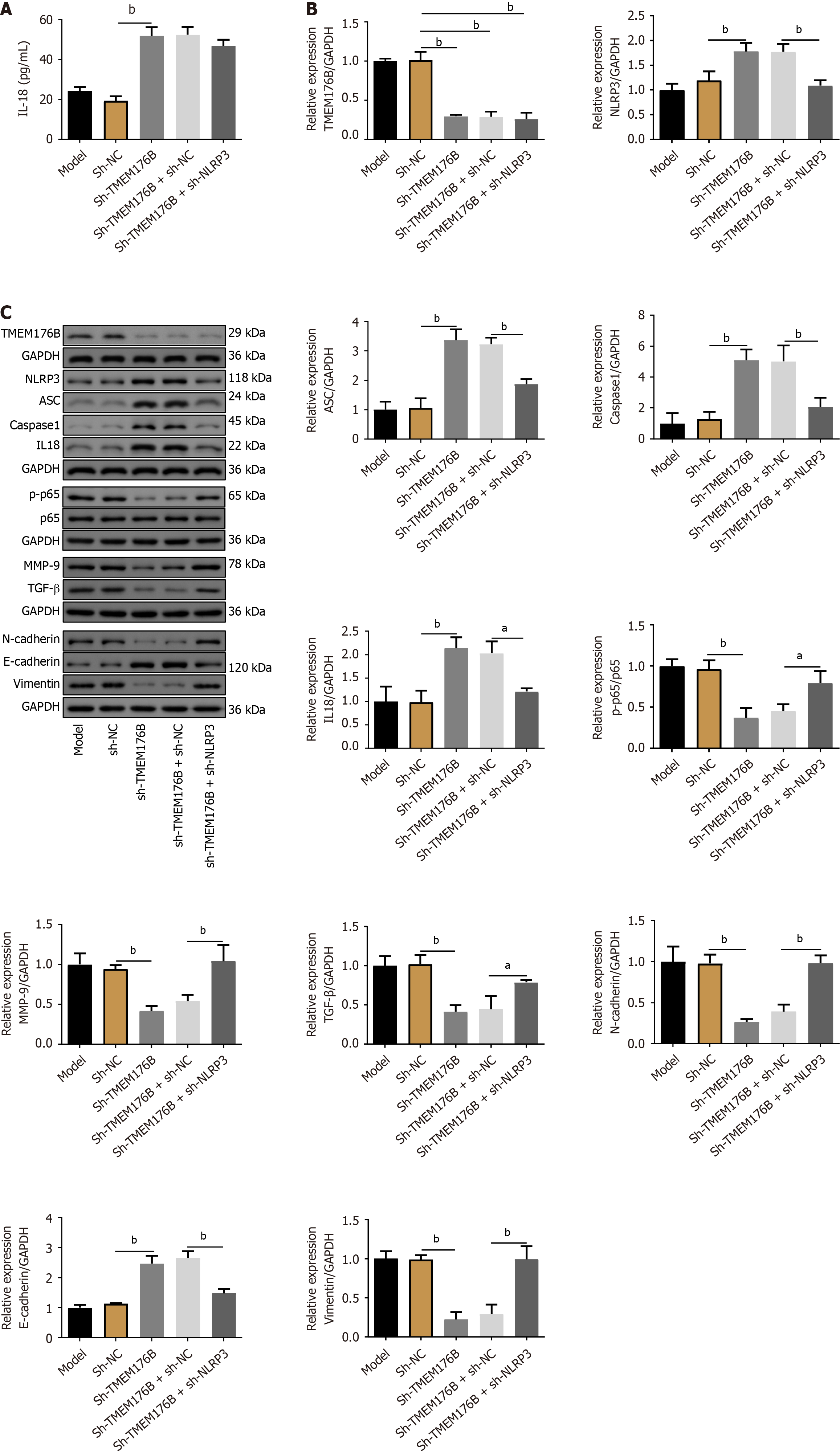Copyright
©The Author(s) 2025.
World J Gastrointest Oncol. Mar 15, 2025; 17(3): 97673
Published online Mar 15, 2025. doi: 10.4251/wjgo.v17.i3.97673
Published online Mar 15, 2025. doi: 10.4251/wjgo.v17.i3.97673
Figure 1 sh-Transmembrane protein 176B inhibits tumor metastasis in colon cancer mice.
A: Fluorescence imaging was utilized to observe tumor metastasis in mice, with the total and average distribution of tumor fluorescence intensity being analyzed across different groups in mice; B and C: Colon tumor tissues in mice were harvested and subjected to Hematoxylin and eosin staining with magnifications of 200 × (scale bar 100 μm) and 400 × (scale bar 50 μm). For each group, n = 3. aP < 0.05; bP < 0.01. sh-TMEM176B: Short hairpin RNA targeting transmembrane protein 176B, sh-NC: shRNA-negative control.
Figure 2 Short hairpin RNA targeting transmembrane protein 176B inhibits cancer promotion in colon cancer mice.
A and B: The TUNEL-positive cells were stained in colon tumor tissues of mice with magnifications of 200 × (scale bar 100 μm) and the percentage of positive cells being calculated; C and D: Immunohistochemistry staining detected the positive expression of Ki67 in colon tumor tissues of mice, with magnifications of 200 × (scale bar 100 μm) and 400 × (scale bar 50 μm). Average optical density is the average optical density, calculated by analyzing the total optical density and area of the image using ImageJ. aP < 0.05; bP < 0.01. sh-TMEM176B: Short hairpin RNA targeting transmembrane protein 176B; NC: Negative control; sh-NC: shRNA-negative control; AOD: Average optical density.
Figure 3 Short hairpin RNA targeting transmembrane protein 176B inhibits the epithelial-mesenchymal transition of colon cancer via the NLRP3 signaling pathway in mice.
A and B: The positive expression and density of NLRP3 and E-cadherin were quantified using immunohistochemistry staining, with magnifications of 200 × (scale bar 100 μm) and 400 × (scale bar 50 μm); C and D: Flow cytometry was used to evaluate CD3-NK1.1+ expression in colon cancer mice. n = 3 in each group. aP < 0.05; bP < 0.01. sh-TMEM176B: Short hairpin RNA targeting transmembrane protein 176B; sh-NC: Short hairpin RNA interference-negative control; EMT: Epithelial-mesenchymal transition; AOD: Average optical density.
Figure 4 Short hairpin RNA targeting transmembrane protein 176B inhibits the epithelial-mesenchymal transition of colon cancer via the NLRP3 signaling pathway in mice.
A: Enzyme-linked immunosorbent assay was used to quantify the expression levels of tumor necrosis factor-alpha and interleukin-18 (IL-18) in colon tumor tissues of mice. n = 3 in each group; B and C: Western blot analysis was used to measure the expression of NLRP3, ASC, caspase-1, IL-18, TMEM176B, p-p65, p65, MMP-9, TGF-β, N-cadherin, E-cadherin, Vimentin in colon tumor tissues of mice. n = 3 in each group. aP < 0.05; bP < 0.01. sh-TMEM176B: Short hairpin RNA targeting transmembrane protein 176B; sh-NC: Short hairpin RNA interference-negative control; EMT: Epithelial-mesenchymal transition; ELISA: Enzyme-linked immunosorbent assay, TNF-α: Tumor necrosis factor-alpha; IL-18: Interleukin-18; TGF-β: Transforming growth factor-beta.
Figure 5 Short hairpin RNA targeting transmembrane protein 176B increased inhibition rate of interleukin-2-exposed natural killer cells on CT26 cells.
A: Flow cytometry was used to evaluate CD3-NK1.1+ cell number and CD107 expression post interleukin-2 (IL-2) stimulation in natural killer (NK) cells. n = 3 in each group; B: Quantitative reverse transcription PCR was applied to assess the relative expression of TMEM176B and NLRP3 in CT26 cells. n = 3 in each group; C: MTT assay was used to determine the inhibition rate of IL-2-exposed NK cells on CT26 cells with TMEM176B or NLRP3 knockdown over 24, 48, and 72 hours. n = 3 in each group. aP < 0.05; bP < 0.01. NK: Natural killer; sh-TMEM176B: Short hairpin RNA targeting transmembrane protein 176B; sh-NC: Short hairpin RNA interference-negative control; IL-2: Interleukin-2.
Figure 6 Short hairpin RNA targeting transmembrane protein 176B inhibits migration and invasion in CT26 cells co-cultured with activated natural killer cells while promoting cell apoptosis.
A-C: Wound healing and Transwell assays were used to assess migration distance, migration and invasion rates of CT26 cells co-cultured with interleukin-2 (IL-2)-exposed natural killer (NK) cells for 12 hours. With magnifications of 200 × (scale bar 100 μm) and 40 × (scale bar 400 μm). n = 3 in each group; D: Flow cytometry was used to analyze the apoptosis rate of CT26 cells co-cultured with IL-2-exposed NK cells. n = 3 in each group. aP < 0.05; bP < 0.01. sh-TMEM176B: Short hairpin RNA targeting transmembrane protein 176B; sh-NC: Short hairpin RNA interference-negative control; NK: Natural killer; IL-2: Interleukin-2.
Figure 7 Short hairpin RNA targeting transmembrane protein 176B inhibits the epithelial-mesenchymal transition process via the NLRP3 signaling pathway in CT26 cells.
A: Enzyme-linked immunosorbent assay was used to quantify the expression of the interleukin-18 (IL-18) in CT26 cells; B and C: Western blot was used to measure the expression of the NLRP3, ASC, caspase-1, IL-18, TMEM176B, p-p65, p65, MMP-9, transforming growth factor-beta, N-cadherin, E-cadherin, Vimentin in CT26 cells. aP <0.05; bP <0.01. sh-TMEM176B: Short hairpin RNA targeting transmembrane protein 176B; sh-NC: Overexpression-negative control; IL-18: Interleukin-18; TGF-β: Transforming growth factor-beta.
- Citation: Qian W, Xu CY, Hong W, Li ZM, Xu DG. Transmembrane protein 176B promotes epithelial-mesenchymal transition in colorectal cancer through inflammasome inhibition. World J Gastrointest Oncol 2025; 17(3): 97673
- URL: https://www.wjgnet.com/1948-5204/full/v17/i3/97673.htm
- DOI: https://dx.doi.org/10.4251/wjgo.v17.i3.97673









